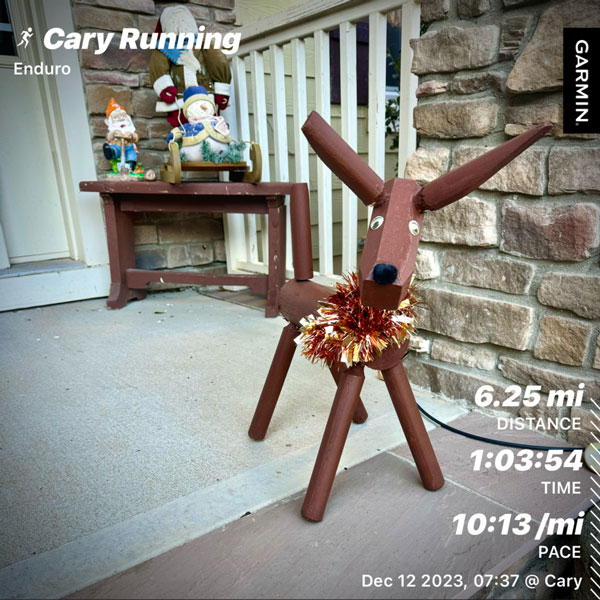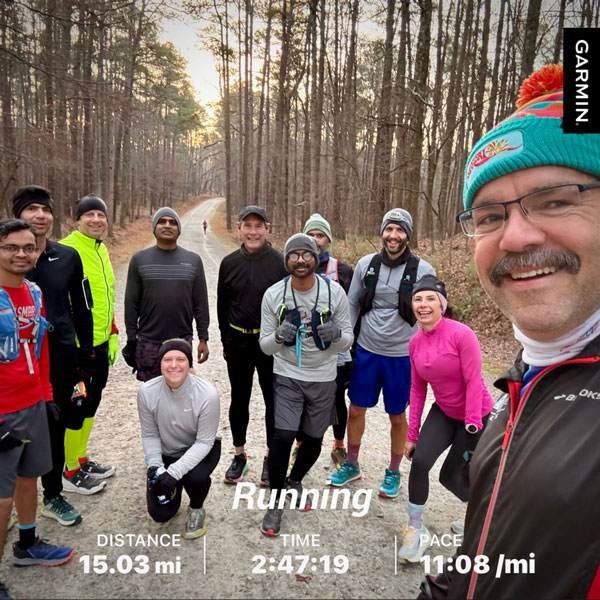In the Pursuit of 24: Week 16
This past week was a recovery week, although we are tackling back-to-back miles; these were lower mileage long runs to allow for recovery. Hopefully, during last week’s event, you were able to practice the quick turnaround each lap, even if you were not able to participate during the event, perhaps during your long runs.
This is part of a series of posts regarding how we prepare, plan, and train to complete the 100 miles Ultramarathon Umstead 100: In the Pursuit of 24. For all the ultrarunning series, here is In the Pursuit of 24, last week’s post, and for additional ideas, follow the link. Training for a 100.
If not, do not worry; we have another great opportunity this coming Saturday when we will tackle one of the long runs. Figure out if you can go to a small loop, a 4- to 5-mile loop or an out-and-back route that will allow you to hit base at least once or twice to practice setup and quick turnaround.
Remember that in a few weeks, some of us will be participating in different events. One of those events is a loop route event that will allow you to put into practice what you have learned and the prep time three times.
Assessment:
Running 100 miles takes a lot of you, physically and especially mentally. While doing your research about it, you will read a lot from experienced ultrarunners about how the actual race begins after the first 55-60 miles (100K). That is mainly because your body is already past that limit of stored glycogen utilization, optimizing for digesting calorie intake and always hovering between the line of significant breakdown versus having the ability to continue to put one step in front of the other at a desired/targeted cadence. You have a plan or an idea of a plan, maybe a dream of how it should go, but not everything is going to go perfectly or go as planned. I promise you, it is a long event, and many things will happen. What you should consider also training for is to do as much as possible that will allow you to prevent/prepare/minimize/adjust for when things happen or quickly address those as soon as possible. In my journey to complete my 1st 100 miles event at Umstead 100, I was able to learn from many challenges and things not going well during training runs. That is when you need those to happen so you can learn, prevent, and handle them during the event. You must continue to talk to friends, research, and take care of a few details pre-event and early in the race that, I believe, will help you achieve a successful under 24hr completion of the 100 miles event. The results of the experience will depend on mental preparation, fueling, recovery, and non-running improvements; each detail, in my opinion, counts to make the difference between an ugly, good, or great event.
Bad training runs: You will be frustrated once in a while with some of the training runs. In a 100-mile training season, there are many long runs. The key here is to take advantage of those runs, especially those that did not go or felt great. Or even better from those runs that felt horrible. Take advantage of the opportunity to rehearse; what would you do if you were feeling the same way during the event? Could you adjust? I remember going to a short base run, and everything was falling apart. My running form was not great; my muscles were super sore, and I felt I was going to start cramping. I thought for a minute that I could stop and call it quits; it was just a base run, or I could try to figure out how to come to the other side and continue. I am glad I did. I slowed down a bit and shifted my mind to the basics to figure out that I needed to adjust the running and breathing techniques. After that, I was able to finish the last few files of the run. I made a mental note to remember that every run is an opportunity to practice, learn, and put portions of the plan together.
Long training runs: Using the actual equipment for the event was vital for me to determine in advance any hot or chaffing spots. When you do a 25-33 mile run, and you end up getting an area with minor irritation, I will bet you that in 100 miles, it is going to get much worse. Finding those areas before the event and figuring out how you are going to handle them is key. I tried a few lube solutions to address those issues in most of the areas. By the way, there were body areas that needed attention that I normally would not even consider during a marathon or shorter distance events/runs. But there was a spot where I had to use a different approach, a combination of lube and taping for my lower back area with Kinesio Tape. The tape worked perfectly to prevent chaffing during my event, and it was something I had in place the night before the event.
Recovery: I use the infamous rolling stick on my legs almost every day. I used to have the rolling stick next to my couch where I watch TV, but I noticed that I rarely used it. So, that approach was useless if I did not use it, but then I thought that if I moved the stick to the shower and made it part of my routine, I would be more successful in using it. That worked perfectly. I was able to almost roll my muscles after every one of my runs. I believe that helped me during recovery as I was doing many back-to-back runs.
Planning:
For your longer runs, we will not be carrying everything we need for the run. Plan to see if you can break your run into 2 or 3 segments that force you to stop and replenish testing your prep work and allow you to learn and determine what things to change, adjust, and improve. As you are practicing and getting ready, here are a few miscellaneous things to consider:
The checkpoint/station/Base: Bring a dirty piece of carpet or doormat to have and use on the ground at your checkpoint or home station if the base station is at a muddy area or if the weather conditions will create a difficult situation when you need to change your running shoes or socks. Especially if the route is a loop, that will come in handy.
If you have a crew helping you, let them know about it so they can have it ready for you. For my 1st 100-mile race, it rained the day before; the ground was very wet and muddy. Having that mat meant I did not have to worry about the wet ground when I changed my socks and running shoes.
No audio?: Need an extra headset?; I like to run with music, audiobooks, and podcasts, and I knew that things could go wrong with the electronics and equipment. Having that extra headset and cheap MP3 player gave me peace of mind. By the way, during my second 100-mile race, I had to use it since, for no reason, the main audio player I was planning to use during my 1st loop did not want to work; I grabbed the spare one when I started running my second loop. I had my other one ready at my checkpoint for the subsequent loops. I also had a couple of USB chargers ready just in case I needed to charge my phone, GPS watch, and other audio devices.
Additional items: Extra pouch to carry additional items if needed. I had the pouch ready to go with the few items I knew I would use. I did not use the extra pouch, but I had it ready there, just in case.
Handling chaffing lube: Painter/painting disposable gloves were something that I was so happy I had nearby during my 1st event. It was cheaper than other disposable options and easy to grab and use. Every time I applied chaffing lube to many areas, I did not want it to get the lube on my hands. That would make handling food and the rest of my equipment a bit more sticky. Having those available allowed me to apply the cream without getting it on my hands. I had that option during my second and third 100-mile events, but I learned to do as much as possible and leave the step of applying lube as a last step before I headed out. It has been risky; there were a couple of times that I forgot to apply, and once, I had to ask the pacer to go back and grab the tube for me to apply about a mile past the home base.
Fuel Research: Even figuring out what they will offer in the event, there were a few items that I knew I wanted to have. I had zip-lock bags with different options for me to grab and go quickly—cookies, chips, crackers, and other things that I could use. There are not many of them, but there is a variety that will help in the case of food getting boring or not great during the run.
Feeling refreshed: A friend of mine recommended bringing a toothbrush and some toothpaste. For that early morning section, a quick brush will trick your brain into waking up and feeling refreshed, plus it will help clean the taste buds that might allow you to start tasting your fuel. At least for a while, I did help me when I brushed before I started the last loop. It gave me a refresher and helped me to stay awake.
Diabetes-related: Do not forget to have your diabetes-related supplies with you, and think about bringing spares of many items you might need. In my case, I had my main testing meter at the central station for me to use. I had another old testing meter at the loop halfway point, just in case. I had in a couple of ziplock bags a couple of infusion spare sets for the pump, extra batteries for the insulin pump, and a spare set for my CGMS sensor. Do not forget to bring your insertion tools and plenty of alcohol swipes to make sure the area is clean before setting it up.
How is the plan going:
This week was recovery but another solid mileage week. The workweek mileage was decent; here are some highlights,
Monday: Some stretches and rest
Tuesday: Easy 6 miles
Wednesday: Morning Yoga followed by 5 miles with the insane running group
Thursday: Easy 4 miles
Friday: Easy long stretches
Saturday: 15 miles at Umstead with the InsaneRunning Group
Sunday: Nice solid two-hour run, a great opportunity to practice running in the rain. Although it was not torrential rain, it was cold rain, which allowed me to test the approach to running and staying warm.
This week’s actual numbers:
| Week 18 | Mon | Tue | Wed | Thur | Fri | Sat | Sun | Total |
| Plan | Stretches & Rolling | 6 | 5 | 3 | Rest | 15 | 11 | 40 |
| Actual | Stretches | 6 | Stretches 5 | 4 | Stretches | 15 | 12 | 42 |
Next Week Plan:
| Week 19 | Mon | Tue | Wed | Thur | Fri | Sat | Sun | Total |
| Plan | Stretches & Rolling | 3 | 5 | 4 | Rest | 24 | 10 | 46 |















